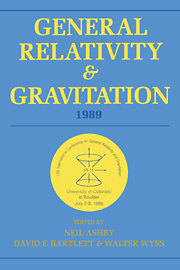 General Relativity and Gravitation, 1989
General Relativity and Gravitation, 1989 Published online by Cambridge University Press: 05 March 2012
In the 20 years after Weber's first publications there have been yearly announcements of new, better ways to detect the signals that everyone knows must be there. Drever, Billing, Douglass and Tyson, Garwin and Levine all built detectors that were of better sensitivity than that estimated by Weber in his original papers. None of those experiments were able to verify Weber's results. In almost every meeting of the past 20 years there have been the promises of the potential of the “second generation” detectors: cryogenic detectors using superconducting instrumentation that would be so sensitive that they would be able to see signals from as far away as the Virgo cluster. In many such meetings for the last 10 years these reports of the potential sensitivity have been tempered by descriptions of the experimental difficulties that were temporarily delaying the attainment of that sensitivity.
The exciting thing about this meeting was that–while there were still tales of wonders to come and of the experimental difficulties that some detectors were confronting–we also had reports of coordinated runs between groups looking for coincidental excitation of their antennas. We had informal meetings outside of the workshops to coordinate data taking and exchange of data. In short, this workshop was the first meeting where three or more groups were confident enough about their detectors that they could talk of coordinating their experiments and of coordinating their existing experiments with the upcoming third generation resonant bar detectors.
To save this book to your Kindle, first ensure [email protected] is added to your Approved Personal Document E-mail List under your Personal Document Settings on the Manage Your Content and Devices page of your Amazon account. Then enter the ‘name’ part of your Kindle email address below. Find out more about saving to your Kindle.
Note you can select to save to either the @free.kindle.com or @kindle.com variations. ‘@free.kindle.com’ emails are free but can only be saved to your device when it is connected to wi-fi. ‘@kindle.com’ emails can be delivered even when you are not connected to wi-fi, but note that service fees apply.
Find out more about the Kindle Personal Document Service.
To save content items to your account, please confirm that you agree to abide by our usage policies. If this is the first time you use this feature, you will be asked to authorise Cambridge Core to connect with your account. Find out more about saving content to Dropbox.
To save content items to your account, please confirm that you agree to abide by our usage policies. If this is the first time you use this feature, you will be asked to authorise Cambridge Core to connect with your account. Find out more about saving content to Google Drive.